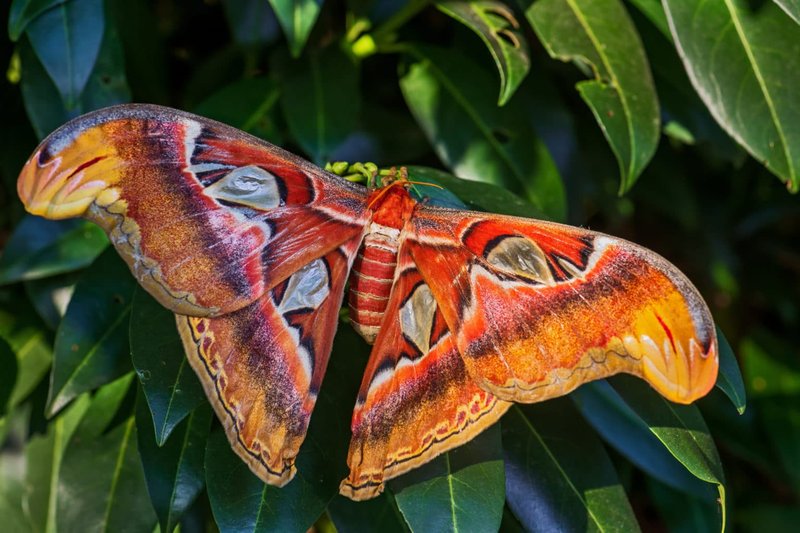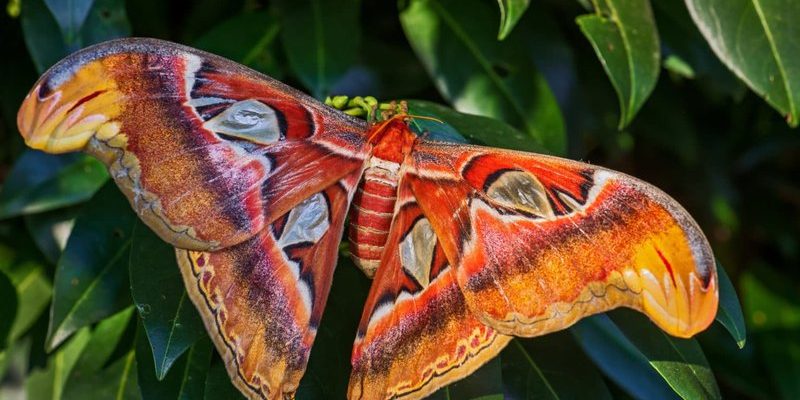
Now, why should we care about comparing the Atlas Moth with similar insects? Just like talking about cars can help you choose the right vehicle, understanding different moths can help you appreciate their unique traits and roles in the ecosystem. In this article, we’ll dive into the world of the Atlas Moth and compare it to some of its close relatives, like the *Hyalophora cecropia* and the *Giant Peacock Moth*. So grab your favorite drink and let’s explore the winged wonders of the insect world!
What Makes the Atlas Moth Special?
The Atlas Moth (*Attacus atlas*) is a giant among moths, native to the tropical and subtropical forests of Southeast Asia. One of the standout features of this moth is its incredible wingspan, often measuring between 9 to 10 inches. That’s about the size of a dinner plate! Its wings are adorned with intricate patterns and colors—rich brown, orange, and cream—that not only make it a sight to behold but also serve as camouflage against predators.
Another remarkable trait of the Atlas Moth is its unique life cycle. Like all moths, it starts as an egg, hatches into a caterpillar, then cocoons itself before emerging as an adult. What’s noteworthy is that adult Atlas Moths don’t have functioning mouths! They emerge from their chrysalises with the sole purpose of mating and laying eggs, often living just a week or two. Think about that—these magnificent creatures spend their lives just to reproduce and then fade away, which is both beautiful and a bit tragic.
A Look at the Hyalophora Cecropia
Let’s shift gears a bit and talk about the *Hyalophora cecropia*, also known as the Cecropia Moth. This North American giant is another impressive creature, with a wingspan that can reach up to 6 inches. While it’s smaller than the Atlas Moth, it makes up for it with its vibrant red, yellow, and black patterns. The Cecropia’s appearance can remind you of a playful painting, full of whimsy and character.
Now, while the Atlas Moth’s life revolves around a short adult phase, the Cecropia Moth takes a different approach. It has a lifespan of about 10 months, allowing it to fully enjoy the beauty of its environment before mating. This moth hibernates during the winter as a pupa, waiting out the cold until it can emerge in spring, making it quite the survivor!
Meet the Giant Peacock Moth
Another noteworthy comparison is with the *Giant Peacock Moth* (*Saturnia pyri*). This moth is a showstopper in its own right and is found in Europe and parts of Asia. Its wings can spread up to 6 to 7 inches and are patterned with eye spots that mimic the eyes of predators, helping to deter birds and other threats. Imagine walking through a lush forest and encountering this eye-catching creature—it’s like coming face-to-face with a living work of art!
The Giant Peacock Moth also has a fascinating life cycle. Like the Atlas and Cecropia Moths, it starts as an egg and transforms into a caterpillar before becoming a pupa. However, adult Giant Peacock Moths have fully developed mouths and can feed on nectar, which extends their lifespan and lets them enjoy life just a bit longer than the Atlas Moth.
Comparing Habitats and Preferences
When it comes to habitats, the Atlas Moth thrives in tropical rainforests, where it enjoys warm, humid conditions. It prefers areas with plenty of trees, as its larvae feed on the leaves of various plants like guava and cinnamon trees. Interestingly, the Atlas Moth’s habitat can indicate the health of its ecosystem, serving as a biological marker for environmental changes.
In contrast, the *Hyalophora cecropia* prefers deciduous forests, often found in urban gardens, parks, and woodlands across North America. It has a wider range of host plants, including maple, birch, and even cherry trees. This adaptability has allowed it to flourish in diverse settings, from rural areas to city parks.
Meanwhile, the *Giant Peacock Moth* is a fan of woodland areas and gardens in Europe. Its specific habitat preferences help it avoid competition with other moths, allowing it to thrive where others might struggle. Habitat choice is crucial for moths, as it affects their food supply, mating opportunities, and overall survival.
Life Stages: The Journey of a Moth
The life cycle of moths is nothing short of magical. All three of these moths undergo complete metamorphosis, which means they experience four distinct stages: egg, larva (caterpillar), pupa (chrysalis), and adult. Let’s break this down a bit.
1. Egg Stage: The female moth lays eggs on a suitable host plant.
2. Caterpillar Stage: Once they hatch, the caterpillars munch on leaves, growing significantly. This stage is all about feeding and gaining energy for the next phase.
3. Pupa Stage: After shedding its skin a few times, the caterpillar forms a protective casing around itself—this is its chrysalis. Inside, it undergoes a dramatic transformation.
4. Adult Stage: Finally, the adult moth emerges, ready to live its brief life to the fullest.
As you can see, while the Atlas Moth might have a shorter adult life span, all three moths share this magical transformation journey, showcasing nature’s creativity and resilience.
The Importance of Moths in the Ecosystem
Moths, including the Atlas Moth, play a crucial role in our ecosystem. They serve as pollinators, helping plants reproduce by transferring pollen. This contributes to the health of the environment, ensuring we have trees, flowers, and crops. When you see a moth flitting around, you’re witnessing a small but essential part of nature’s cycle.
Additionally, moths are a food source for many animals, from birds to bats. They’re part of the food web, helping sustain various wildlife species. Without them, the balance of nature would be disrupted. By comparing the Atlas Moth to others, we notice that each species contributes uniquely to its environment, making the preservation of these insects vital.
Conservation and Future of Moths
Sadly, many moth species, including the Atlas Moth, face threats from habitat loss, climate change, and pollution. As forests are cut down and temperatures rise, their habitats are disappearing. This is where we, as individuals, can make a difference. When we support conservation efforts, we help protect these extraordinary creatures and their environments.
Making simple changes in our gardens—like planting native plants and avoiding pesticides—can create a welcoming space for moths. Just think about how amazing it would be to see a giant Atlas Moth flutter around your yard! By educating ourselves about these insects and advocating for their protection, we can contribute to their survival.
In conclusion, comparing the Atlas Moth with similar insects enriches our understanding of these incredible creatures. Each moth has its own story and role to play in the ecosystem. Whether you’re captivated by the beauty of the Atlas Moth, the resilience of the Cecropia Moth, or the striking appearance of the Giant Peacock Moth, it’s clear that these insects deserve our attention and care. Nature has a lot to teach us, and by appreciating the small wonders, we can foster a healthier planet for all living beings.

